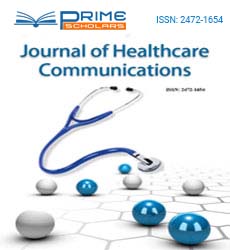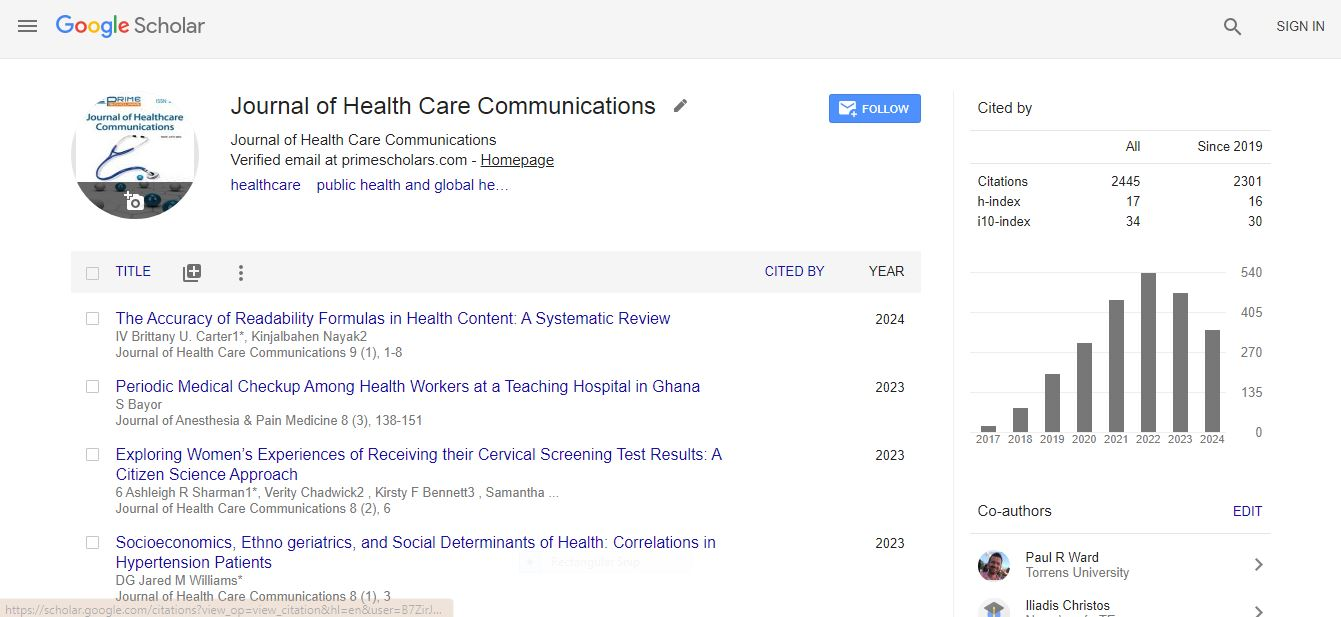Short Communication - (2025) Volume 10, Issue 2
Healthcare Financing: Communicating Costs, Access and Transparency
Weng Xuen*
Department of Nursing, Capital Medical University, Beijing, China
*Correspondence:
Weng Xuen, Department of Nursing, Capital Medical University, Beijing,
China,
Email:
Received: 03-Jun-2025, Manuscript No. IPJHCC-25-22773;
Editor assigned: 05-Jun-2025, Pre QC No. IPJHCC-25-22773 (PQ);
Reviewed: 19-Jun-2025, QC No. IPJHCC-25-22773;
Revised: 26-Jun-2025, Manuscript No. IPJHCC-25-22773 (R);
Published:
03-Jul-2025, DOI: 10.36846/2472-1654.25.10.66
Description
Healthcare financing refers to the mechanisms through which resources are generated, allocated and managed to ensure the delivery of medical services. It includes public funding, private insurance, out-of-pocket payments and alternative financing models. Effective communication in healthcare financing is essential because patients, providers, policymakers and insurers must understand how costs are structured, how benefits are distributed and how responsibilities are shared. Miscommunication or lack of transparency often leads to mistrust, financial hardship, or inequities in access to care.
A primary area of communication in healthcare financing involves interactions between patients and insurers. Insurance documents often contain technical terms and complicated reimbursement procedures that are difficult for patients to interpret. When patients do not understand their coverage, they may delay care, avoid essential treatments, or face unexpected expenses. To address this, insurers and healthcare providers must use clear, concise language to explain coverage details, co-payments, deductibles and exclusions. Providing cost estimators and transparent billing statements improves patients’ ability to plan and make informed decisions about their care.
Government communication also plays a central role in healthcare financing. Publicly funded healthcare systems, whether universal or means-tested, depend on citizens’ understanding of eligibility, benefits and procedures. For example, health ministries must explain how subsidies work, which services are included in basic benefit packages and how to apply for financial assistance. Without clear communication, populations most in need may remain unaware of their entitlements and fail to access care. Public outreach campaigns, multilingual resources and community engagement strategies are often used to improve awareness of financing mechanisms.
Hospitals and providers also face challenges in communicating about costs. Patients frequently express frustration with surprise bills, unclear itemized charges, or hidden fees. Transparent billing practices, pre-treatment cost estimates and accessible financial counseling services are essential in reducing this confusion. Financial counselors, in particular, serve as communicators who bridge the gap between patients and complex healthcare billing systems, ensuring that individuals understand their options for payment plans, insurance claims, or government support.
Healthcare financing is not only about cost-sharing but also about resource allocation within systems. Policymakers must communicate their decisions about where funds are directed whether toward preventive care, hospital infrastructure, workforce development, or emerging technologies. Public trust depends on the perception that resources are distributed fairly and efficiently. Transparent communication about budget priorities, trade-offs and expected outcomes strengthens accountability and helps communities understand why certain investments are made.
In low- and middle-income countries, healthcare financing communication often focuses on donor-funded initiatives and community-based insurance schemes. Explaining these programs to rural or underserved populations requires tailored approaches that consider literacy levels, cultural beliefs and local languages. When financial mechanisms are poorly communicated, they risk being underutilized despite their potential benefits. For example, community-based health insurance programs may fail if households do not fully understand how pooling contributions protects them from catastrophic medical expenses.
Healthcare financing is closely tied to the concept of equity. Effective communication ensures that marginalized groups are aware of their rights and can access financial protection. For instance, programs designed for maternal and child health or chronic disease subsidies must be publicized widely and explained in simple terms. Failure to communicate inclusively can reinforce disparities, leaving disadvantaged groups to bear disproportionate financial burdens.
The rise of digital platforms has also influenced communication in healthcare financing. Online portals allow patients to check insurance coverage, submit claims and track reimbursements. Mobile applications provide reminders for premium payments and updates on policy changes. While these tools increase efficiency, they also introduce new communication challenges. Not all populations have equal digital literacy and some may distrust automated systems. Therefore, companies must provide alternatives such as call centers, community agents, or in-person support to ensure inclusivity.
Another key dimension involves international communication about healthcare financing. Global organizations such as the World Health Organization (WHO) and the World Bank often engage in discussions with governments to design financing models that align with sustainable development goals. These discussions require transparent sharing of financial data, policy outcomes and evidence-based strategies. When effectively communicated, international collaborations can strengthen health systems and improve population outcomes.
Healthcare financing also intersects with ethical considerations, particularly in discussions about rationing or prioritization of resources. Communicating these decisions requires sensitivity, as stakeholders may perceive trade-offs as unfair or politically motivated. Clear, evidence-based communication about why certain treatments are subsidized while others are not helps manage expectations and avoid misunderstandings.
Finally, patient education about financial planning for healthcare is an often-overlooked component. Encouraging individuals to consider preventive care, health savings accounts, or supplemental insurance requires ongoing communication through community programs, workplaces and schools. This proactive approach helps reduce the burden of unexpected medical expenses and contributes to financial stability at both household and system levels.
Conclusion
Healthcare financing is not only a technical matter of budgets and payments but also a field where communication shapes access, equity and trust. From patient billing explanations to national policy announcements, clear and transparent communication determines how effectively financial systems support healthcare delivery. By simplifying complex insurance terms, providing transparent billing practices, engaging communities and using both digital and traditional communication channels, stakeholders can ensure that financing mechanisms are better understood and more widely utilized. Ultimately, effective communication in healthcare financing enhances fairness, reduces financial stress and strengthens the overall sustainability of health systems.
Citation: Xuen W (2025) Healthcare Financing: Communicating Costs, Access and Transparency. J Health Commun. 10:66.
Copyright: © 2025 Xuen W. This is an open-access article distributed under the terms of the Creative Commons Attribution License, which permits unrestricted use, distribution, and reproduction in any medium, provided the original author and source are credited.

